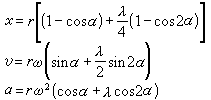2) Dynamic condensation


动力缩聚
1.
A dynamic condensation technique via inverse iteration method;


基于逆迭代法的结构动力缩聚技术
2.
Based on the theory of solution to the Lyapunov and Riccati matrix equations,in this paper an in-depth analysis of the convergence of iterative dynamic condensation methods is provided and the sufficient conditions for their convergence are introduced.
利用Lyapunov矩阵方程和Riccati矩阵方程解的理论,对迭代动力缩聚法的收敛性进行了分析证明,并给出了迭代收敛的充分条件。
3.
In order to reduce the degree of freedom of finite element models to make it consistent with corresponding experimental degree of freedom, based on the modified system eigen-equation, a new iterative dynamic condensation formula, which reflects the transforming relation between system s major and minor degrees of freedom has been deduced.
为了给有限元模型降阶,使有限元模型的自由度和实验模型的自由度相一致,从修改后的系统的特征方程出发,推导出一个新的反映主副自由度变换关系的计算动力缩聚矩阵的迭代公式。
3) dynamic reduction


动力缩聚
1.
An updating algorithm has been devised utilizing the sensitivity of FRF together with the dynamic reduction with respect to the selected design parameters.
利用试验测试和预测的有限元模型计算得到的频响函数 (FRF) ,在结构动力缩聚技术的基础上 ,推导出了一种改进的基于频响函数的灵敏度分析的修正方程。
2.
On the basis of Ref[1],an improved approach to dynamic reduction and model modification of a mathematical model, in which reduction and modification techniques are used simultaneously, is proposed in this paper.
本文在文[1]的基础上,提出一种改进的综合运用动力缩聚与动力修改技术的方法,为提高系统修改矩阵的识别精度,利用先验信息,即有限元模型缩聚后的质量、刚度阵做为迭代初值,建立迭代方程修正质量(或刚度)阵。
4) dynamic condensation


动力聚缩
1.
A Ritz dynamic condensation algorithm of orthogonal expansion analysis for stochastic structures;
随机结构正交展开分析的Ritz动力聚缩法
5) copolycomdensation kinetics


共缩聚动力学
6) dynamic condensation


动态聚缩
1.
In this paper,a method of dynamic condensation is put forward,which can beused in complex modes with damped oscillation system.
本文提出一种建立有阻尼振动系统动态聚缩模型的方法。
2.
A dynamic condensation model based on optimization principle is presented.


提出了一种基于优化原理建立的动态聚缩模型。
补充资料:动力机械:内燃机动力学
研究内燃机运转中的力学现象的科学。其主要任务是研究分析内燃机运转时各主要零件的运动规律及其受力情况﹐用以作为内燃机零件设计﹑计算的依据。它还研究这些力对内燃机动力装置的影响及其消减方法。内燃机动力学的主要内容为曲柄连杆机构运动学﹑曲柄连杆机构动力学和内燃机平衡分析等。
曲柄连杆机构运动学 研究曲柄﹑连杆﹐尤其是活塞的运动规律。活塞作周期性往复运动时的位移 、速度
、速度 和加速度
和加速度 可用下述各式近似求算
可用下述各式近似求算

式中 为曲轴转角﹔
为曲轴转角﹔  为曲轴旋转角速度﹔
为曲轴旋转角速度﹔ 为曲柄半径﹔
为曲柄半径﹔ 为曲柄半径
为曲柄半径 与连杆长度
与连杆长度 之比﹐即
之比﹐即  =
=  /
/ 
曲柄作回转运动﹐连杆作复杂的平面运动。连杆的运动往往被简化分解为随活塞组的往复运动和随同曲柄的旋转运动。
曲柄连杆机构动力学 研究分析曲柄连杆机构(见曲柄滑块机构)在运动中力的生成﹑传递和输出。作用在曲柄连杆机构上的力有曲柄连杆机构运动时产生的往复惯性力和离心惯性力﹐以及内燃机气缸内的气体压力。
说明:补充资料仅用于学习参考,请勿用于其它任何用途。
参考词条